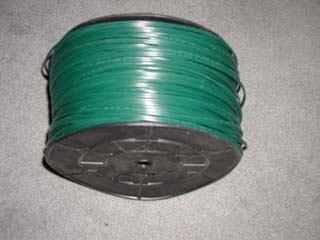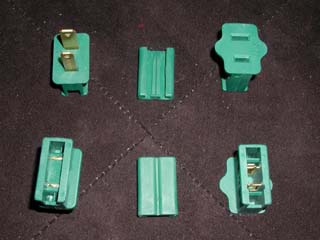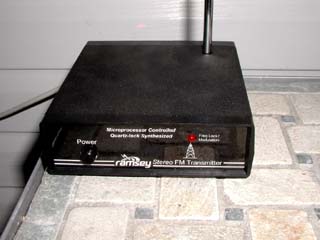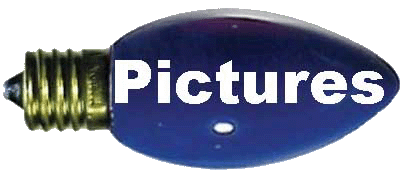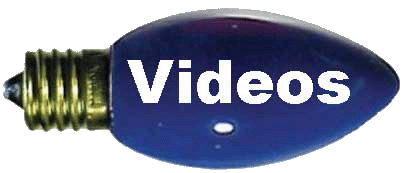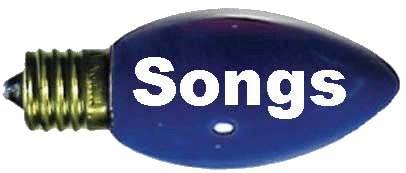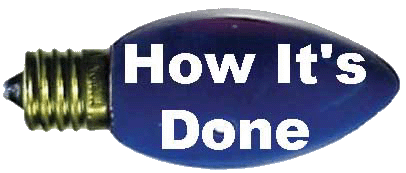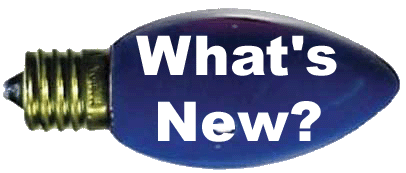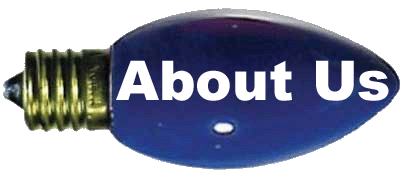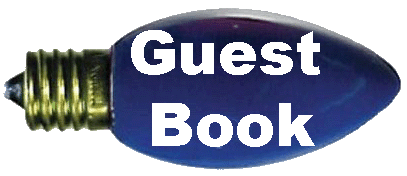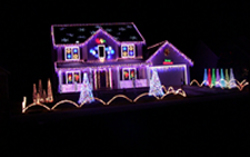

![]()
I figured it was
time to update the how it's done page (old
page)
Give some insight into more of the sequencing side.
What do I need to get started?
If
you do it like me, where the show runs from a computer in
the house
you will need at least one
controller board, one
USB adapter, the
software,
one network (cat5) cable and your choice of lights.
The lights are
controlled using hardware and
software from a
very fine company called
Light-O-Rama.
How do I sequence a song?
This is the hardest part. A common question is - "how long does it
take to do that?"
The short answer is "a long time". I average about 3 hours for
every 15 seconds
of song. If you want results like mine, where the lights are
synced to the various
elements of the music/voices then that's a good average.
How do you sequence a song?
I lay out the house with the animation window. I add anything new
to the house
and export it for use in all the other songs. You can use a
picture of your
house, but I don't. This works just fine for me.
Click any picture to make it full size.
I split my sequencing into 1/20 second chunks. I know that
everyone says you can't tell
the difference when it's 1/10 of a second, but I can and using 1/20
gives me very tight
sequencing. No light is more than 2/100 of a second off.
Label your channels
so you know what they mean. Lay them out in some orderly fashion.
Here's a snippet of Christmas Eve in Sarajevo as the house lights scroll up.
I like to fade a majority of the lights, looks really nice when you have
long fades but work just as well with short fades. I like to use
ramps as my
fading default. Let's me see it much better on the screen vs
shading.
Listen to the song lots and
lots and lots of time. I probably listen to a song
100 times before I even sequence it. Start to split it out in my
mind.
Are there subtle nuances? What kind of drum(s) are there?
Symbols?
Does the music lend itself to use the 6 windows, 4 porch spindles,
6 porch posts?
If I use the leaping arches around the yard, should all sections be on
or should they leap?
After I have a good idea of what the song does, lay it out on paper?
Drums will
use the stick trees on the right, symbols will use the spiral tree
forest on the left,
main song will be the house, etc. Sometimes I can't really
describe a part so I'll
just write down what I hear - dum dee dee dum section will be the porch
spindles.
Does the song start out slow and build
up? Then my lights do the same, if it's
slow I'll start with one color of light, as it builds I'll add more
color, is the song
totally going crazy? - Time to add the strobe lights.
If at all possible don't change it up
in the middle of the song.
If the drums are the stick trees, then they are the stick trees the
entire song.
Try to keep moving segments together. If you are trying to light a
series of
drum beats don't light the stick tree, then jump to the upper left
window, then the
front right tree, then the garage icicles. That makes no sense and
looks like
a blind monkey just whacked the keyboard (which unfortunately a lot
of shows look like).
I'll program one
element until there's a change in the song, usually starting with
the first thing on the song. Tweak it as necessary, listen to it
again, play it
in animation mode. Is it what you want? Go back and do the
next section and
repeat. Copy and paste are you friends, but don't rely on them
totally. Unless
the whole song was digitally done (put a drum beat every two seconds
exactly) then
there will be slight changes. Things will need to be moved, 1/20
of second back or forth.
Use the wave
form, it definitely helps in finding major beats. Use the speed
function
to slow it down in difficult parts. I use 1/2 speed. Use
audacity
to help.
Take frequent breaks, revisit
the song even when it's done. I keep finding things
to change 6 years later (was that 3 beats or 4 beats?).
My advice is to get started very early. Even with free sequences
it's going to take a lot of work to get it to match your house layout.
I start in December for the next year. What lights do I need, hit
the
Christmas clearance sales. How will this effect all my current
songs?
What new songs do I want to do? Buy 'em and start listening to
them
and then start sequencing them. You'll get burned out, so leave
plenty of time.
How do I hook it all up?
Each controller card comes standard to
power 15 amps on each side.
This is your typical outlet in any house. I've upgraded my
controller
cards to 20 amps by swapping out the fuses, but this requires
20 amp circuit breakers, 20 amp plugs, 20 amp outlets,
and upgraded wiring to 12 gauge. With LEDs it should not be
a problem keeping 8 channels under 15 amps.
One controller card will likely take up two outlets on
separate
circuit breakers, so plan accordingly. If you are going to use
less
than 15 amps total on the entire card you can bridge the two
sides and getaway with one power source. The more controllers
you have the more sources of power you will need and this will
probably take adding new circuit breakers, new wire runs, new outlets,
etc.
Since the
controllers are outside controlling lights exposed to the
weather
it is highly recommended to plug everything into GFCI outlets.
I had a dedicated 200 amp panel put in a couple years ago just for
the Christmas lights, this feeds another 100 amp subpanel. All of
these
feed 26 dedicated 20 amp GFCI outlets
Now you need a way to get the power to the controller cards (which are
hopefully inside a weatherproof case). I prefer putting the
controllers
by the section I'm going to light up. I just need two long runs of
extension
cord from the outlet to the box, versus 16 long runs to the lights.
For 15 amps I just the orange extension cords available from any
store. For 20 amps I've been using 12 gauge romex with a 20 amp
plug.
I wrap it in electrical tape only for the sake of making it black.
Not the preferred way I'm sure, but it is the cheaper alternative.
6 years running and no issues.
I chose to make my own extension
cords that go from the controller
box to each set of lights. I buy the wire in bulk, 1000 foot
spools.
It is standard 18 gauge lamp wire, or flat wire, or zip cord.
It typically comes labeled as SPT1 or SPT2. SPT2 has thicker
insulation.
I've been sticking with SPT1 because it's lighter.
I cut the wire to any desired length and
attach
a 'vampire' plug to one end. This type of plug is super easy to
connect. Slip the wire in a groove, slide on the top and two
little
fangs pierce the insulation and make contact with the copper wire.
You can also use the normal everyday extension cords that are sold
at any store. They say indoor use only, but I've never had any
trouble using them outdoors for the short amount of time I need them.
You can use these instead of making your own, just cut off the
appropriate plug end and you're done. Just be sure to get
vampire plugs for your type of wire (SPT1 or SPT2).
I've started out cutting my cords to the exact length I
needed
but quickly found out next year that those no longer worked as
more lights were added. Now I just use a standard length of 15 or
20
feet. Better to be too long than too short.
Now that you have the hardware, synchronized a song or
two,
and have your electrical needs all in place, it's time to hook it all
up.
When you buy your hardware you will also need to get a connection
for your computer. I chose the
USB adapter with booster.
From the USB adapter I run Cat5 cable to the first controller and
daisy chain more Cat5 cable to each additional box. Now all the
controllers can talk to each other. Since my controllers are
spread
around the house I bought premade 50 and 100 foot lengths of cable.
Since I chose to synchronize to
music there had to be a way for
visitors to hear the music, otherwise it's just a bunch of blinking
lights. I bought a low power FM transmitter. This is a legal
way
to broadcast music over the FM channels. I found an empty
channel (107.1), set the controller to that channel and now visitors
can listen to the music from the comfort of their cars. I also
chose
to play the same music in the yard. I put a radio in the garage,
tuned it to 107.1, placed some outdoor speakers in the yard and
now people walking by can listen as well
(albeit at a low non-neighbor disturbing volume).
How do I make the computer
run the show?
After you have your sequences all developed you will need
to put these
into a "show". A show is where you define in which order you want
the songs
to play. You can also put in a startup sequence ("Hi, welcome to
our show"),
a background sequence that plays during the regular show (I have my sign
and nativity as a background sequnce), animation sequences (I have the
rainbow tree in the backyard as an animation sequence), musical
sequences
and shutdown sequence ("The show is over for tonight, thanks for
coming").
You can also have interactive sequences where your audience can trigger
something to happen. 2009 I had a big button on the donation box,
this
would trigger 10 tomato cage trees to come to life in the neighbors
yard.
You can choose to play the musical sequences in order or shuffle, have a
delay, etc. I go in order with no delay. I insert
announcements between
each song as musical sequences ("you just heard...up next...").
Finally you have to schedule the shows. What days
do you want it
on, what times do you want it play, etc. The computer will start
it when
you want and will end the show after a sequence stops after your off
time.
This way you don't have to schedule to the minute. If a new show
starts
at 9:45 and a full show is 50 minutes long and your off time is 10:00,
the computer will turn it off after 10:00 when the current sequence stops.
So
10:01 or 10:02 or whatever. It won't go the full 50 minutes.
It always surprises me to read the comments on youtube
about "how can
you sleep with all that blinking?". You'd think if someone figured
out how
to make tens of thousands of light blink in unison to music that they'd
also figure out a way to turn it off when it's bedtime!!!
Now the big question. Where can I get all of this stuff?
|
Hardware/Software |
|
|
Circuit Breakers |
Your local home improvement store. |
|
Your local home improvement store, but you'll pay a lot. |
|
|
Your local home improvement store, but
you'll pay a lot. |
|
|
Wire |
Home improvement stores sell it by the foot or on 250 foot
spools. |
|
Vampire Plugs |
I've only found these online. Action Lighting or Creative Displays has them in different styles (male or female) and colors. I also went with Christmas Light Show for these too. But lately I've been going with Home Depot online. They refer to them as slide-on plugs. They are the cheapest I've found, but you'll need to buy 100 at a time and they sell out quick. Better to have too many than not enough. |
|
This can be found almost everywhere. Since I needed 100's of feet I went online. I got mine from a place called Cables For Less. You can buy different colors and lengths and the prices are very reasonable. Or make your own, like I've taken to doing. |
|
|
I chose the Ramsey 25B FM transmitter, but there are others out there. It comes in a kit where you have to solder everything together. If you have no knowledge of soldering electrical components I suggest you buy a prebuilt one. I got mine on ebay for just a bit more than the cost of the kit. |
|
|
Weatherproof Enclosures |
My original enclosures that I modified came from Home Depot. They are sold as water sprinkler timer enclosures. Cut out the guts and the controller card fits nicely. Light-O-Rama now sells custom made enclosures for some of their controllers. |
|
Lights |
The best place to buy incandescent lights are your local stores - Wal-Mart, Target, K-Mart, home improvement stores, etc. Online light prices do not compare to their prices. But occasionally you will need to shop online for certain lights. In my case the C9 bulbs that I use. The stores typically don't sell single color C9 strands and when you need to replace just the light bulb it's best to go online. I like Action Lighting and Creative Displays for their bulk bulbs. If you need 500 or more bulbs of a single color, then that's your best bet. For LED lights you will need full wave LED's, they allow you to fade them. Most local stores only sell half wave, but that might be changing. Another thing to keep in mind is the quality. Many, if not all local stores have bulbs that come out, like normal lights, but the metal they use corrodes, it's not copper. Keep 'em outside to get wet and they're done with the next year. That's a lot of money to throw away. I only get my LED's online, they are typically of solid construction, the bulb, socket and wire are all formed at once, no loose bulbs, no water to get inside. Find an early group buy (February early), pay a down payment and when they are made and shipped you will get them (May, June, July), pay the rest. Now you have lights for a long time. I used Magic in the Sky Lighting this year and was very happy, as I didn't need to buy an entire case of one type/color. |
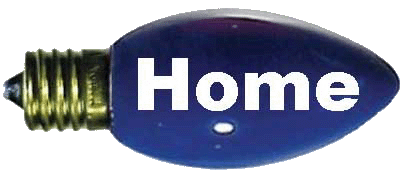
|
